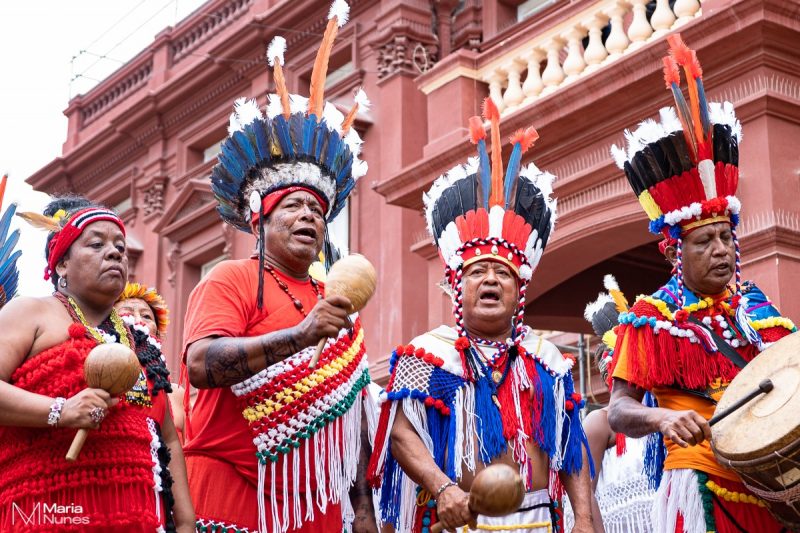 [1]
[1]Visiting Surinamese Lokono people (Arawaks) at the reinterment ceremony of the First Peoples’ bones at the Red House in Port of Spain, Trinidad, October 19, 2019. Photo by Maria Nunes, used with permission.
When restoration of Trinidad and Tobago's Red House [2] — the seat of the country's parliament before the building fell into disrepair — began in 2013, construction workers found the bones of as many as 60 Tainos, [3] indigenous islanders. In a long-awaited reinterment ceremony [4] on October 19, 2019, their remains were finally laid to rest once more.
The indigenous people of Trinidad and Tobago are commonly called First Peoples, a term which includes the original inhabitants of the islands prior to the arrival of Christopher Columbus [5] and his Spain-funded ships. When the bones were first [6] discovered [7], construction on the Red House came to a halt so that a full archaeological excavation could take place. The process eventually confirmed that the bones belonged to approximately 60 ancestors, believed to be 47 adults and 13 children. Investigations [8] — which included radiocarbon dating — revealed that these ancestors had lived on the island between the estimated dates of 125 and 1395 AD.
 [9]
[9]The remains and artefacts of 60 Amerindian ancestors, which were reinterred at a ceremony in Port of Spain, Trinidad, October 19, 2019. Photo by Maria Nunes, used with permission.
This revelation was quite significant to photographer Maria Nunes, who captured images of the reinterment. In a Facebook update, she noted [8]:
[T]he remains are pre-Columbian […] This reveals to us that our capital city of Port of Spain today was a place of human community for close to 1,500 years before the first Spanish contact in 1492.
Indeed, the discovery [10] confirmed that life and settlements had been thriving in the country's current capital, Port of Spain, for over 1,000 years.
For the First Peoples community, it was a reclamation of an important piece of their past. At the reinterment ceremony, the Santa Rosa First Peoples’ Chief, Ricardo Bharath-Hernandez, said [11] it was a way for their ancestors to speak to them and a moment to properly commemorate their dead:
Some may look at this ceremony as something that does not matter, neither important nor significant. But just as most of us treat our dead with respect, and use the appropriate rituals in their own tradition, we feel very strongly that the remains of our ancestors should be respected and treated likewise.

Chief Ricardo Bharath-Hernandez conducts a sacred ritual to lay the bones of the First Peoples’ ancestors to rest at the Red House in Port of Spain, October 19, 2019. Photo by Maria Nunes, used with permission.
Of the ceremony itself, he said [11] that it was significant not just because it allowed the remains to be put back where they were found, but because it acted as a moment to shine a light on the struggles of the First Peoples community, which has not always been afforded the recognition [12] and respect that it is due.
Local members of the First Peoples community, as well as Taino representatives from other Caribbean, South and Central American territories, including Dominica, Guatemala, Guyana, Suriname and Venezuela, were present for the reinterment. Government officials and media also witnessed the ceremony.
 [13]
[13]A member of the visiting Surinamese Lokono contingent plays a flute at the reinterment ceremony on October 19, 2019, in Port of Spain. Photo by Maria Nunes, used with permission.
In a Facebook Live of the event by university lecturer Rhoda Bharath, it is evident the descendants of the First Peoples played a vital role [14] in the ceremony. Their chief called on the “Great Spirits” for guidance and to sanctify the area where the remains were being placed, after which each representative made his own call or offering to the dead. Rituals included singing, often to the accompaniment of indigenous instruments like the shak shak [15], drums and flutes. Various members of the community performed their own rituals and offerings before the remains were buried.
Many netizens were moved by the ceremony, which they saw as a historical moment in the country's history and a chance to show due respect to the descendants of the islands’ indigenous people.
On social media, posts containing photos [8] and videos [14] of the ceremony [16] were flooded with likes [17] and comments [18] about how emotive the observance was:
Many citizens are unaware that (human) remains of the ancestors of Trinidad’s indigenous First People were discovered while renovating The Red House -its one of the reasons it’s taken so long. Their remains are being buried today. So touching.
— Kris⭐️ (@KrisClarkie) October 19, 2019 [19]
Facebook user and First Peoples descendant Dale Orosco added [20]:
By looking at these images there is a feeling that can't be expressed with words, thoughts of my forefathers long gone, the stories told by grandpa of his forefathers that is us [.] It pains me to the core, it also gives the feeling of relief that our people who [were] disturbed from sleep are finally given peace again.
 [21]
[21]The proposed design for the monument to the country's First Peoples, to be installed at the site. Photo by Maria Nunes, used with permission.
Fayola Rudder shared [22] a similar sentiment:
Finally respect for the first people on whose shoulders we stand […]
Chief Hernandez thanked the government for fulfilling [23] its promise [24] to keep the bones at the Red House, and for the monument dedicated to the indigenous people of Trinidad and Tobago on the site.
He also announced [25] that he and the Santa Rosa First Peoples community may advocate for an annual public holiday [12] honouring the First Peoples. Despite originally being against it because of the already high number of national holidays in Trinidad and Tobago, he said the community — and its opinion on the issue — was evolving.